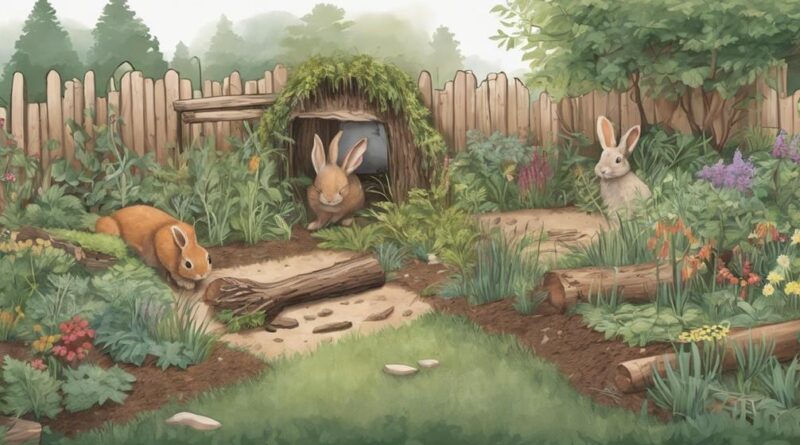What Steps to Take for Creating Natural Rabbit Habitats?
Before you put all your eggs in one basket, consider the importance of creating natural habitats that cater to the specific needs of rabbits. Ensuring the well-being and sustainability of these furry creatures requires careful planning and attention to detail.
From understanding their behavior to selecting the right location and providing suitable vegetation, each step plays a crucial role in establishing a thriving rabbit habitat. But what about the lesser-known aspects that could make a significant difference in their quality of life?
Understanding Rabbit Behavior
To understand rabbit behavior, observe how they interact with their environment and each other. Understanding their behavior patterns is crucial when creating natural living spaces for them. Rabbits are naturally curious and energetic animals that thrive in environments that allow them to exhibit their natural behaviors. When designing their habitat, consider incorporating elements that mimic their natural surroundings.
Rabbits have specific behavior patterns that are important to consider when creating their living spaces. They're social animals that enjoy the company of other rabbits, so it's recommended to keep them in pairs or groups whenever possible. Providing hiding places, tunnels, and elevated spots in their habitat allows them to display their natural instincts, such as burrowing and exploring. Additionally, rabbits are prey animals, so they need spaces where they can feel secure and retreat if they sense danger.
Observing how rabbits interact with each other can also provide valuable insights into their behavior. They establish hierarchies within their groups, so it's essential to provide enough space and resources for each rabbit to establish their territory. Understanding their body language, vocalizations, and social interactions can help you create a habitat that promotes their well-being and allows them to express their natural behaviors. By considering these aspects of rabbit behavior, you can design a natural living space that meets their physical and psychological needs.
Selecting the Right Location
When selecting the right location for your rabbit habitat, consider factors such as sunlight exposure and proximity to potential predators. Conduct a habitat assessment to evaluate environmental factors that may impact your rabbits' safety and well-being. Here are some essential steps to guide you through selecting the optimal location:
- Assess Habitat Suitability: Before setting up the rabbit habitat, evaluate the area for factors like soil quality, vegetation types, drainage patterns, and existing wildlife populations. Ensure the location can support the specific needs of rabbits, such as suitable foraging opportunities and hiding places.
- Check Sunlight Exposure: Rabbits thrive in habitats with access to both sunlight and shade. Choose a location that offers a balance of sunlight exposure throughout the day, allowing rabbits to regulate their body temperature effectively.
- Evaluate Predator Risks: Identify and mitigate potential risks posed by predators in the area. Avoid locations close to known predator habitats or areas with high predator activity. Consider installing predator deterrents or choosing locations that naturally provide protection against threats.
- Prepare the Site: Clear the land effectively to create a safe and functional habitat for your rabbits. Remove any harmful plants, debris, or obstacles that could pose risks to the rabbits. Level the ground and ensure proper drainage to prevent waterlogging.
Providing Shelter and Protection
Consider the construction of sturdy shelters to provide your rabbits with essential protection in their habitat. Building burrows can offer a safe space for your rabbits to hide from predators and seek shelter from harsh weather conditions. When creating burrows, ensure they're well-constructed to prevent collapses and provide adequate protection. This natural form of shelter mimics their instinctual behavior and gives them a sense of security.
In addition to burrow construction, implementing predator prevention measures is crucial. Installing fences or barriers around the habitat can help deter predators from accessing the rabbits. This physical barrier adds an extra layer of protection, reducing the risk of potential threats to your rabbits' safety.
Creating hideaways within the habitat using natural materials can also offer protection and a sense of security for your rabbits. Incorporating camouflage techniques such as placing branches, twigs, and leaves around the habitat can help rabbits blend in with their surroundings, making it harder for predators to spot them.
Choosing Suitable Vegetation
What types of vegetation are best suited for creating natural rabbit habitats? When selecting vegetation for rabbit habitats, it's essential to consider plant diversity and employ suitable landscaping techniques to ensure a thriving environment for these furry creatures. Here are some tips to guide you in choosing the most appropriate vegetation:
- Native Plants: Opt for native vegetation as they're well adapted to the local climate and soil conditions, providing a natural habitat for rabbits.
- Ground Cover Plants: Include low-growing plants like clover, grasses, and herbs to create a lush ground cover that offers hiding spots and foraging opportunities for rabbits.
- Shrubs and Bushes: Incorporate shrubs and bushes such as blackberry bushes, raspberry bushes, or blueberry bushes to provide rabbits with shelter, nesting sites, and a varied diet.
- Perennials: Plant perennial flowers and plants like coneflowers, bee balm, or sedum to attract pollinators, which can benefit the overall ecosystem of the rabbit habitat.
Ensuring Food and Water Sources
To ensure a thriving natural rabbit habitat, it's crucial to provide adequate food and water sources for the rabbits. Water availability is essential for the well-being of rabbits as they need to stay hydrated to maintain their health. Ensure that fresh, clean water is readily accessible to the rabbits at all times, either through water dispensers or shallow dishes that are easy for them to drink from.
When it comes to feeding habits, understanding the foraging behavior and natural diet of rabbits is key. Rabbits are herbivores that mainly consume grass, hay, and leafy greens. To mimic their natural diet, offer a variety of fresh vegetables like kale, parsley, and carrots. Providing a mix of these foods will help ensure that the rabbits receive the necessary nutrients for their growth and development.
In addition to vegetables, hay should make up a significant portion of their diet. Timothy hay, orchard grass, or oat hay are excellent choices for rabbits as they aid in digestion and help wear down their teeth, which continuously grow. Introduce new foods gradually to prevent digestive issues and observe which ones are favorites among your rabbits.
Implementing Safety Measures
Implementing safety measures to safeguard the well-being of rabbits in their natural habitat is crucial for creating a thriving environment where they can exhibit natural behaviors and thrive. Here are four essential steps to consider:
- Safety Precautions: Take measures to remove any potential hazards from the rabbit habitat, such as sharp objects, toxic plants, or small openings where they could get stuck. Regularly inspect the area to address any safety concerns promptly.
- Environmental Enrichment: Provide a variety of natural elements like rocks, logs, and tunnels to encourage physical activity and mental stimulation for the rabbits. This enrichment helps prevent boredom and promotes overall well-being.
- Predator Deterrence: Install fencing or barriers to deter predators from entering the rabbit habitat. Consider using motion-activated lights or sound devices to scare off potential threats during the night.
- Habitat Maintenance: Regularly maintain the habitat by cleaning the area, replenishing food and water sources, and repairing any damage to structures. A well-kept habitat not only ensures the safety of the rabbits but also promotes a healthy and sustainable environment for them to thrive.
Monitoring and Adapting Habitats

Monitoring and adapting habitats is essential for ensuring the long-term sustainability and well-being of rabbits in their natural environment. To effectively support rabbit populations, regular habitat observation is crucial. By closely monitoring the habitats, you can identify any changes or issues that may arise, allowing you to adjust strategies promptly. This proactive approach enables you to address potential problems before they escalate and impact the rabbits.
In addition to habitat observation, habitat enrichment plays a significant role in promoting species interaction and overall well-being. Introducing diverse vegetation, shelters, and enrichment items can enhance the habitat's quality, providing rabbits with opportunities for exploration, foraging, and social interaction. By observing how rabbits interact with these enrichments, you can gain valuable insights into their preferences and behaviors, allowing you to further tailor the habitat to their needs.
Promoting Biodiversity and Sustainability
Enhancing the natural rabbit habitats through the promotion of biodiversity and sustainability is crucial for supporting a thriving ecosystem. To achieve this, consider the following steps:
- Habitat restoration: Implementing habitat restoration practices can help recreate natural environments that support diverse plant and animal species, providing rabbits with ample food sources and shelter. By restoring degraded habitats, you can enhance biodiversity and create a more sustainable ecosystem for rabbits to thrive in.
- Conservation efforts: Engage in conservation efforts aimed at protecting natural habitats from human disturbances and encroachment. Preserving existing ecosystems ensures that rabbits have a safe and stable environment to inhabit, promoting biodiversity and sustainability in the long run.
- Maintaining ecological balance: Strive to maintain ecological balance within natural ecosystems by avoiding the use of harmful chemicals and pesticides that can disrupt the delicate relationships between species. Promoting a healthy balance between predators and prey helps sustain a harmonious environment for rabbits and other wildlife.
- Supporting native species: Focus on supporting native plant species that are well-adapted to the local environment, as they play a crucial role in providing food and shelter for rabbits. By promoting the growth of native vegetation, you help create a biodiverse habitat that supports the long-term sustainability of rabbit populations.
Frequently Asked Questions
Can Rabbits Coexist With Other Wildlife in a Natural Habitat Setting?
In a natural habitat setting, rabbits can coexist with other wildlife, but it comes with challenges. Wildlife interactions may vary, affecting ecological balance. Habitat management is crucial to promote coexistence.
Creating diverse habitats that cater to different species' needs can foster a harmonious environment. However, it's important to monitor interactions to ensure the well-being of all animals involved. Balancing the ecosystem requires careful planning and ongoing observation.
How Can I Prevent Predators From Entering the Rabbit Habitat?
To keep predators out of the rabbit habitat, focus on predator prevention by installing sturdy fencing.
Create natural hiding spots and camouflage the habitat to make it harder for predators to spot the rabbits.
Remember to regularly check and maintain the fencing to ensure its effectiveness in keeping unwanted visitors away.
Are There Any Specific Plants or Trees That Should Be Avoided When Creating a Rabbit Habitat?
When creating a rabbit habitat, be mindful of toxic plants that could harm your furry friends. Avoid landscaping choices that include poisonous vegetation, such as lilies, azaleas, or daffodils.
Opt for safe landscaping options like clover, dandelions, or pansies, which are rabbit-friendly and won't pose any garden dangers. By selecting the right plants and trees, you can ensure a natural and safe environment for your rabbits to thrive in.
What Impact Does Weather and Seasonal Changes Have on a Natural Rabbit Habitat?
Weather and seasonal changes play a crucial role in a natural rabbit habitat. Climate resilience is essential for habitat adaptation.
Rabbits rely on seasonal food sources and shelter construction to survive changing conditions. Understanding how weather impacts vegetation and predator behavior is key to creating a thriving habitat.
Is It Necessary to Introduce Additional Wildlife Species to Promote Biodiversity in a Rabbit Habitat?
Introducing additional wildlife species can be beneficial for promoting biodiversity in a rabbit habitat. Wildlife introduction fosters habitat coexistence and diversity, creating a more balanced ecosystem.
Conclusion
Creating natural rabbit habitats involves several key steps:
- Understanding their behavior
- Selecting the right location
- Providing shelter and protection
- Choosing suitable vegetation
- Ensuring food and water sources
- Implementing safety measures
- Monitoring and adapting habitats
- Promoting biodiversity and sustainability
By following these steps, you can create a habitat that mimics the rabbits' natural environment, allowing them to thrive and live happily in a safe and sustainable ecosystem.
